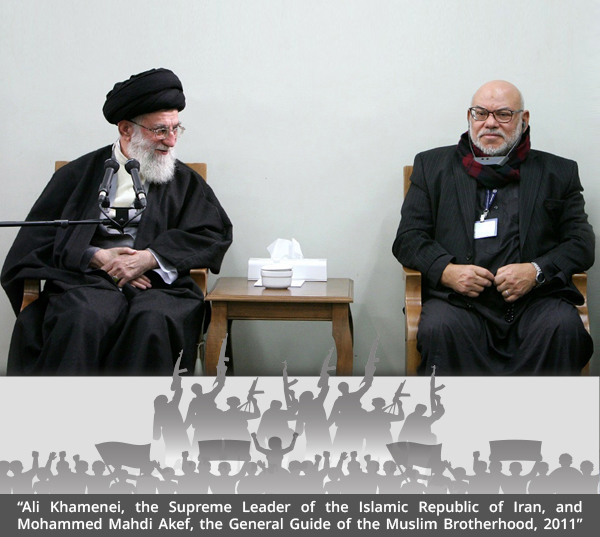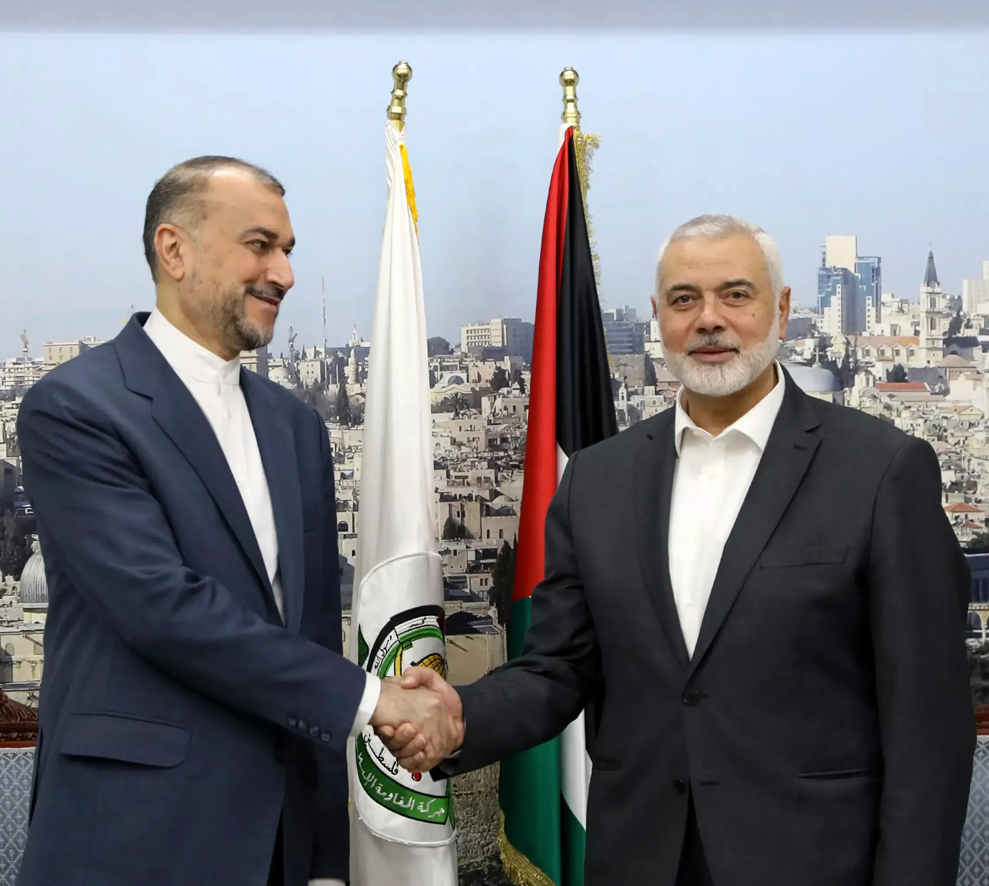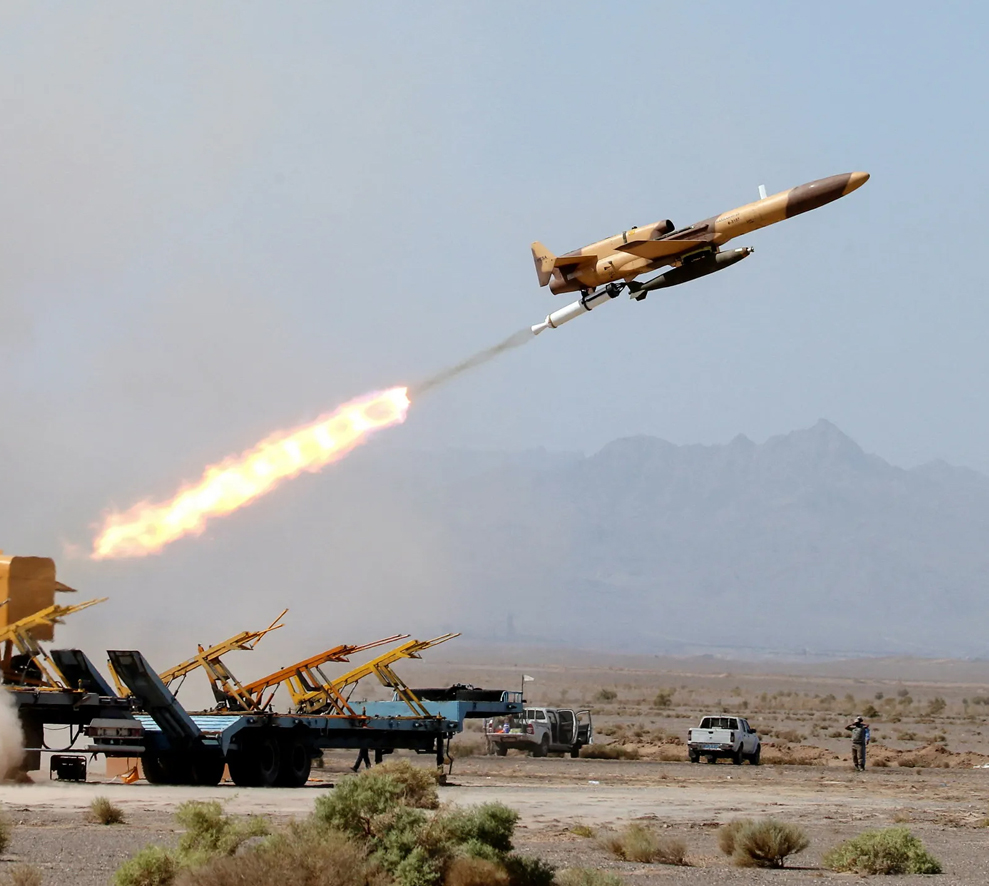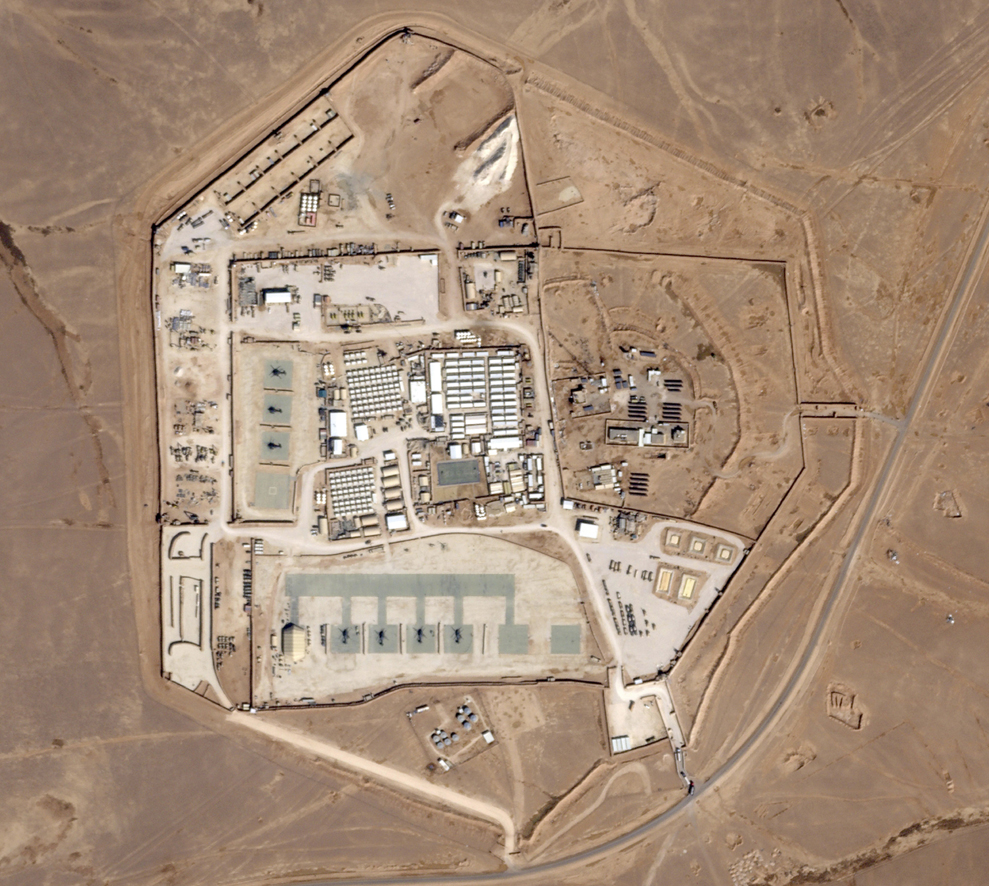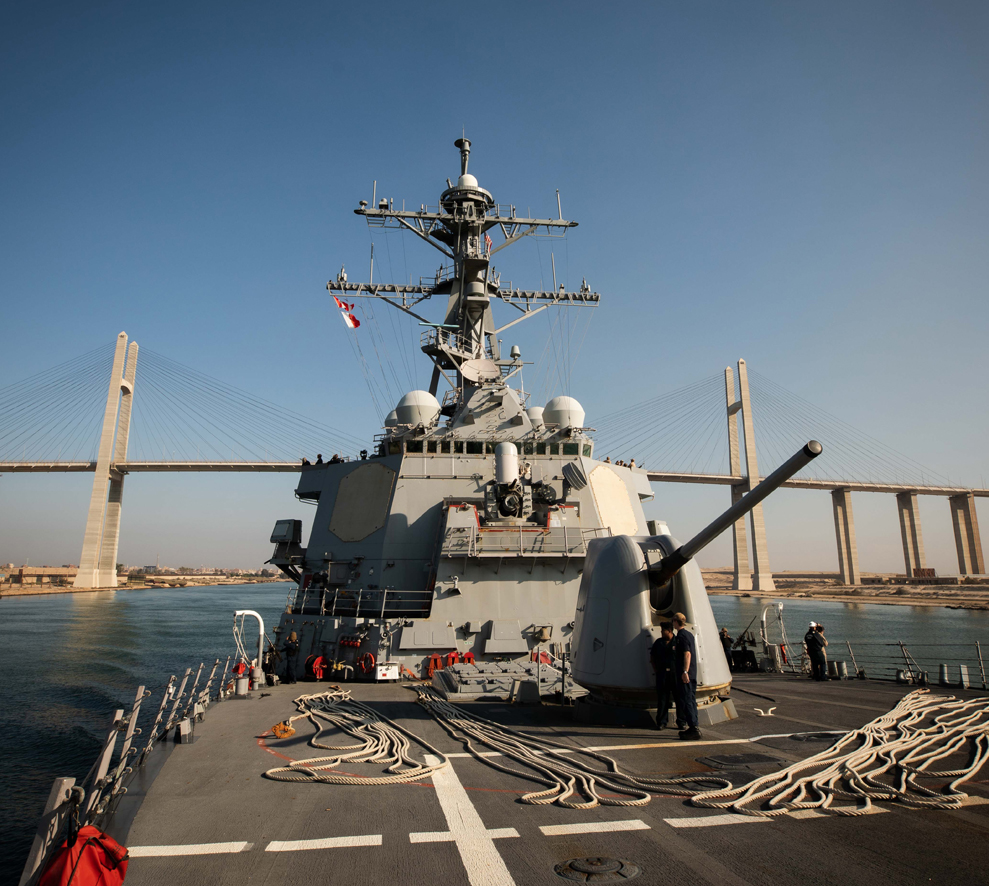This paper is a part of the series: Political Islam in Focus
A number of ideological common factors and relations throughout history, embody the structure and identity of the rapprochement, between the Muslim Brotherhood and Iran since the 1979 Islamic Revolution. The ideological concepts, ideas, and references converge of such relation's parties of political Islam -whether being Sunni or Shiite- were transferred, affected therewith, and been affected thereby, in spite its differences between the two doctrines.
Political Islam in Iran was affected by Hasan al-Banna, Sayyed Qutb, Al-Madoudi and others. On the other hand, the Iranian revolution was reflected in the approach and paths of Sunni Political Islam groups in the region. Both sides have the same political attitudes and perceptions regarding the relationship with the West, and the approach to the Palestinian-Israeli conflict. Both of which converge at the centrality of the religious and rhetorical dimension, and the stand from the modern state.
In this paper, we note three main common factors, which constitute the framework and general activity of both Iran and the Muslim Brotherhood in particular. The most important of which is the call for Islamic unity, along with an expansionist view, that transcends homelands and geographical boundaries, in addition to the "establishment and restoration of the Islamic caliphate" as the ultimate goal and purpose of political action. Based on these common factors, the motivation was established for the two parties to bring relations and cooperation, even influence, thoughts, and behavior closer, to each other.
1. The Call for Islamic Unity
For decades, Iran has been strengthening its relations with all different Islamic countries and sects around the world, in order to impose more hegemony and influence in the service of its political project. This appeared in countries, such as Iraq, Lebanon, and Syria. Iran has gone on to employ all possible tools for this long-term strategic purpose, like establishing the Conference on Islamic Unity, by the invitation of the Global Council for the Convergence of Islamic Doctrines in Iran.
Holding such annual Conference comes during the days of Prophet Mohammad Mass, or the so-called "the Islamic Unity Week" between 12 to 17 Rabi’ al-Awwal (Hijri calendar). This Conference was first established in 1981, upon a suggestion from Ayatollah Montazeri, and under an approval from Khomeini, the Revolution's supreme leader.
Thus, the Iranian calls for Islamic unity meet with their counterparts from the currents of political Islam, which represent the most prominent determinants of their political and Da'awa (call to embrace Islam) joint work. Therefore, when reviewing the political discourse of either side, we see that is always calls to unite the Islamic nation in the face of its "virtual" enemies, and to spread its ideology globally.
In this context, it is worthy to refer to the views of the Islamic writers prominent figures, who support the idea of the Islamic Unity as promoted by Iran, and supported by the currents of political Islam. Including the Syrian Islamic writer Mahmoud Shaker al-Harstani, who says in his book (The Islamic History) "The nation is not associated with a particular spot of earth, rather, the work arena of the Muslim nation is the whole earth. Wherever {the Islamic Nation} can establish the rule of God, then that is its first foothold and its spot of emergence. Then, its circle would expand from it by Da'awa, spreading this idea, and by jihad to cover the whole earth. As long as this idea does not spread to the whole earth, and does not rule the whole world with what God has revealed, then the mission of the Nation would remain. There is a huge burden for the Nation, which is jihad for the sake of God, so that it can apply God's method to the whole earth". [1]
2. The Islamic Caliphate
Despite the historical divergence, upon the nature of the term "Islamic Caliphate" or "imamate" between the two sides; Sunni and Shiite, but the political and pragmatic motivation brings the two parties closer together for such idea, even if the tools used to realize this idea may differ. Talking about that idea, and the need to achieve it, increased immediately after the fall of the Ottoman caliphate in 1924.
The Muslim Brotherhood was one of its most prominent advocates for that idea. This appeared in the messages of the Muslim Brotherhood's founder; Hasan al-Banna, particularly, the message of the Fifth Conference entitled "the Muslim Brotherhood and Caliphate", in which he said "Perhaps, it is better to complete this research by presenting the stand of the Muslim Brotherhood towards the caliphate and related issues thereto, and to show that the Muslim Brotherhood's believes, which are that the caliphate is the symbol of Islamic unity, and a manifestation of the correlation between the nations of Islam. In addition, it is an Islamic ritual, that Muslims must think about and pay attention to. The Caliph is assigned to many rules in the religion of God". [2]
Parallel to the Brotherhood's approach, many political Islam movements were created in all Muslim countries. Particularly in Iran during the 1950s, which the then Shiite cleric Mujtaba Mirlohi, known as Nawab Safavi; founder of Iran's fundamentalist organization "Fedayeen Islam" which is similar to the Muslim Brotherhood's approach and organization, became a member therein and adopted its ideas. This confirms the early correlation and the interlinking between the political Islamist currents in Egypt and Iran, started since Safavi visited Egypt with Imam Khomeini, and met with the founder of the Brotherhood; Hasan Al-Banna, in 1939. [3]
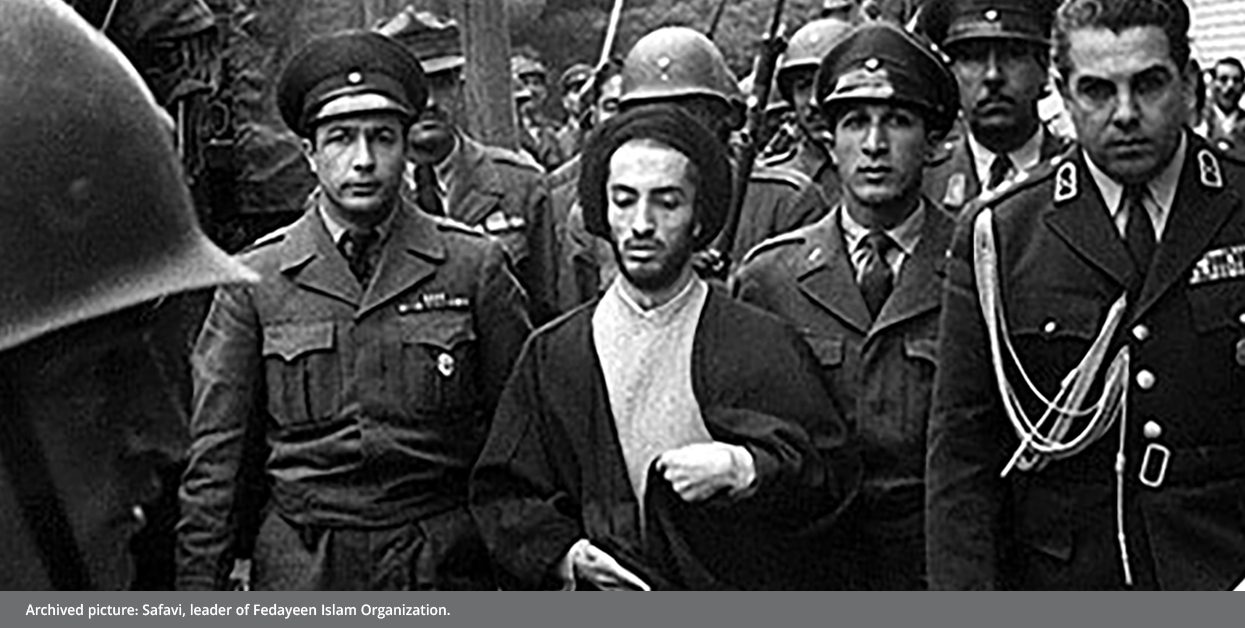
Over time, the term "Islamic Caliphate" transformed into "The Islamic State", in which not only the currents of political Islam and Iran have met, but also included violent jihadist groups, such as al-Qaeda and ISIS, which, at the time, are based on the belief and ideological principle of "Hakemyya" (the Divine Rule on Earth) which similar to the principle of "Faqih Rule" for Shiites during the Khomeini revolution, where such principle did not exist before Khomeini's revolution. Both principles meet on the stands and perceptions regarding the society, the common enemy, and other issues.
3. Expansionist Ambitions
Iran's opponents consider that expansionism and the dissemination of ideas of the "Islamic Revolution" dominate its foreign policies, in accordance with the principle of "exporting the revolution", which Khomeini made it be its top principles and issues. Iran foes see that it uses the hotbeds of conflict and disputes in the Middle East to find a foothold for its agents, undermine the influence of its opponents. They add that Iran's' ultimate goal is to create a pro-national "belt", which transcends the national borders, extending from Iran to Lebanon, including Iraq and Syria, that is: a similar thing to the ambitions of the Persian Empire in the past, but this time in a special way, based on both its revolutionary ideology and loyalty to the Supreme Leader. This is a scenario causes a great concern to Iran's neighbors, leading them, sometimes, to work in order to prevent it from being achieved.
Iran's foreign policy is centered on serving its expansionist objectives, which strategically include the "Islamic world". This is why Iran targets higher Islam's highest principles away from the sectarian divergences when addressing the general Muslim community. Such an approach was pursued since the 1979 Islamic Revolution, and its carries its agenda by virtue.
Considering The Islamic movements, we find that they resisted the sectarian tendency at the beginning of their start and work. The founder of the Muslim Brotherhood; Hasan al-Banna, had contributions in the Sunni-Shiite dialogue. This was rooted in their stands from many regional issues at the time, for example: their support for the so-called "Constitution Revolution" in Yemen 1948, which produced a national charter that changed the nature of the state system into an Islamic approach, combining the intellectual foundations of Al-Shafei and Zaidi sects.
Equally, there was a correlation between the Muslim Brotherhood and the Da'awa party, led by Mohammad Baqir al-Sadr. It is to be mentioned that Sadr's writings and preaches were circulated among Islamists, in the same manner the ideas of Sayyid Qutb and Al-Daoudi were circulated among Da'awa party members.
However, the relations between the two sides of political Islam (Sunni and Shiite) were affected by the rise of Salafist jihadist movements, and their extremist attitudes towards the other, which restored the sectarian relations in accordance with the win-lose rule, as it has historically been. This was reflected in hotbeds of conflict and rivalries over power and resources, and emerged more specifically after the Iraq war in 2003 and then the Syrian crisis in 2011. [4]
The "Islamic Revolution" and the Role of the Muslim Brotherhood in it
The Islamic Revolution in Iran had complex relations with political Islam current in the Arab world, outside the Muslim Brotherhood, such as its relations with the Palestinian Islamic Jihad Movement, which, in its early stages, described itself as "supporters of the Islamic Revolution in Palestine." Fathi Shakaki, the movement's former secretary general, was heavily influenced by Khomeini's revolution in Iran, and believed that Khomeini had launched the Islamic awakening in the region and around the world.
In this context, it is no secret that Iran has also enjoyed close relations with other Islamist movements inside Palestinian, other than Islamic Jihad, led by Hamas. Iran has also led the so-called "resistance" axis in the region.[5]
The Muslim Brotherhood had contacts with Iranian clerics, who later became actors in the "Islamic Revolution". According to media sources, Hasan al-Banna's relations with Iranian religious leaders, established the basis of the "Revolutionaries" and later the "Islamic Revolution", such as Nawab Safavi, who was invited to the Islamic Conference for the Liberation of Jerusalem, 1953, by Sayyid Qutb, as well as a subsequent invitation from the Muslim Brotherhood to Safavi to visit Egypt. Safavi was quoted as saying during his meeting with Mustafa Al-Sibai, the group's observer in Syria "he who wants to be a true Jafari should join the ranks of the Muslim Brotherhood". It is to be noted that Iran's current Supreme Leader, Ali Khamenei, has entered politics through Safavi, and that he -i.e., Khamenei- is fan of Sayyid Qutb [6], where he translated two books by Sayyid Qutb: "This Religion" and "Landmarks in the Road".
It is clear from the foregoing that the concepts of the Iranian Islamic movement, and its Revolution, was influenced, in one way or another, by the ideology of the Muslim Brotherhood. In addition to Safavi, other activists cooperated with the Muslim Brotherhood, and played a prominent role in enabling the Iranian Islamic movement to reach the office, including Ibrahim Yazdi, who was a representative of the Revolution leader, and the first supreme leader of the Islamic Republic; Ruhollah Khomeini. yazdi became the foreign minister in the first post-revolutionary government in 1979.
The relations between the Muslim Brotherhood and Iran's Islamists continued after the success of the revolution. The Muslim Brotherhood's Reform Party was founded in Tehran, and was then headed by Abdul Rahman Birani. In fact, the Islamic Revolution in Iran had an impact on political Islam groups, particularly the Muslim Brotherhood. In his book (The Repercussions of the Islamic Revolution in the Muslim World) Dr. Manouchehr Mohammadi, an official in the Iranian Foreign Ministry, said "The Islamic Revolution was able have an influence on the Muslim Brotherhood movement to some extent. So that the General Secretariat of the International Organization of the Muslim Brotherhood in Egypt, initiated contacting with the officials of the Iranian Islamic Revolution as soon as it prevailed. It congratulated Iran on the victory of the revolution" adding that "in 1979, the Muslim Brotherhood published a book entitled: The Islamic Alternative, considering that Khomeini's style and the Islamic Republic represent the way of the Islamic solution to rid them of puppet regimes". [7]
The Egyptian Da'awa magazine (which the main platform of the Brotherhood in Egypt) published at that time a statement by Abu al-Alawi al-Mudoudi, replying a question about the stand from the Iranian revolution "The Khomeini's revolution is an Islamic revolution, and those who are responsible for it are an Islamic group, and young people who have been educated in Islamic movements. All Muslims in general, and Islamic movements, in particular, should support this revolution, and cooperate with it in all fields". [8]
From its part, Iran has used its relations with political Islam groups, to improve its relations and consolidate its influence in the Muslim world. Beyond that, the two sides take a unified stand towards the U.S. presence in the region. Iran wants a cross-border supporter to resist this US presence. In addition, the role of political Islam currents in mediating between Tehran and radical or Salafist-oriented Islamist groups, which view Iran as an anti-Islamic force in the Middle East.
As for the Muslim Brotherhood, its sees that there is an interest in its relations with Iran, to present itself as a group calling for Islamic unity, so that it would practice a pressure on the Arab countries, particularly those that take an opposing stance on Iran's expansionist policies. But given the developments of the so-called "Arab Spring", the Muslim Brotherhood was to restrict the size of its relations and cooperation with Iran. The Muslim Brotherhood concerns about the stand of Western countries, particularly the United States and Britain, which have a negative image of Iran's foreign policies. However, once the Muslim Brotherhood came to power in Egypt 2011, it did not hesitate to make contacts with Iran. [9]
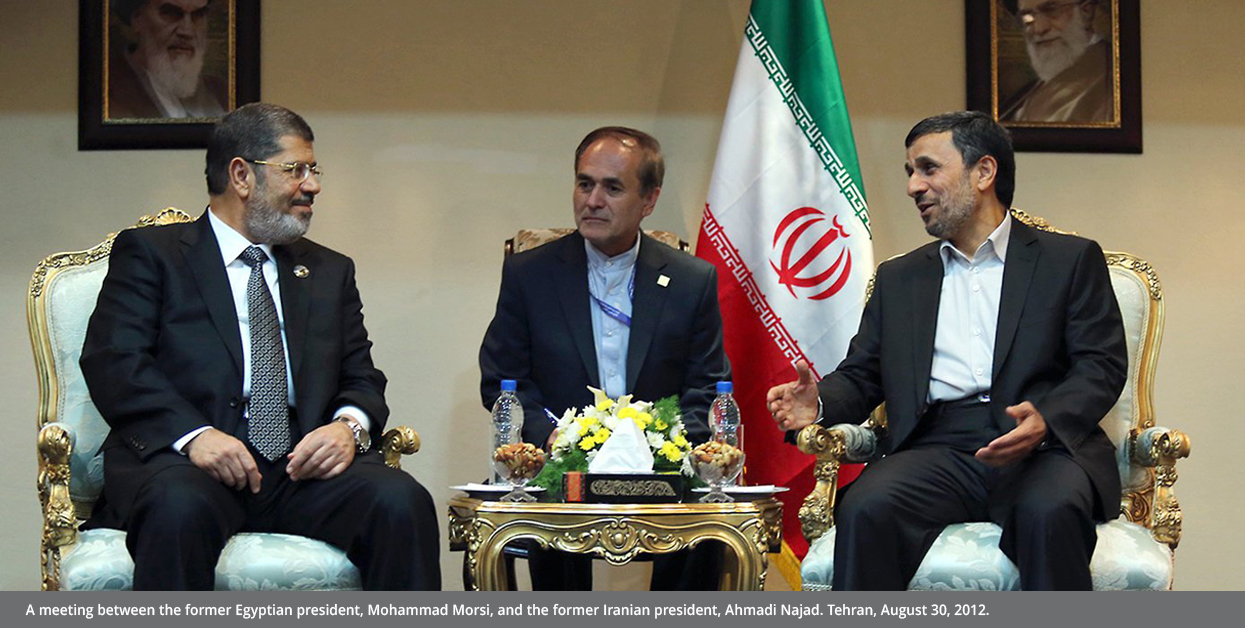
The Islamic Revolution and the Awakening of the Radical Extremism
The "Islamic Revolution" and its success in 1979, represented a motivation and a radical momentum that changed the region's shape, orientations, lifestyles, and legislative, social, and economic systems. it created a significant historical and a fundamental turn, not only in Iran's history, but in the history of the region and the world.
The Egyptian journalist, Mohamed Hassanein Heikal, on the day he met Khomeini in Paris, December 1978, just two weeks before the Shah's departure from Iran on January 16, 1979, described the founding of the Islamic Revolution Council on the same day as "a bullet that was shot from the seventh century and settled in the heart of the 20th century".
With the success of the "Islamic Revolution" and the establishment of the model of the Supreme Leader, for which the rhetoric of the Muslim Brotherhood was framed and established, a new chapter began in the region and the world. This created the starting point for what became the "Islamic Awakening". This coincided with the failure of nationalist and leftist projects, to realize their proposed ideas about liberation, and the elimination of affiliation, after the nationalists and the leftists ruled throughout the 1950s and 1960s, and faced a series of setbacks, including Arab defeat in the wars of 1948 and 1967.
The Islamic Revolution was the acme for the Islamic Awakening, after it restored the concepts of Islamic rule to political options and alternatives in the region, and succeeding in inaugurating the first religious leader since the fall of the Ottoman Empire in 1924.
The Islamic Revolution was the main motivation and catalyst for all political Islam groups to act, be active, and unite, in order to achieve their goals of Islamizing the societies, and confront the ruling regimes, besides establishing their revolutionary protest rhetoric which challenges the governments. The impact of the Islamic Revolution has extended to Iranian-backed groups, or those sympathetic to its experience. It even reached various groups, such as Salafist and extremist groups, that have sought to emulate what took place in Iran. Such groups were actively expressing themselves and their activities, challenging the governments and everyone, while heading towards radicalization.
Sources of the Radical Influence of Khomeini's Revolution
1. The First Success for the Political Islam Movements in the 20th Century
The success of Khomeini's Islamic Revolution, was the first success achieved by the Islamic political movement, in establishing a state according to its references; and its and expansionist and hostile for the region and the world. Egypt, the Gulf states, and Pakistan were key targets in Khomeini's speech, as demonstrated in an archived interview with CBS Network journalist; Mike Wallace, following the success of the Islamic Revolution, where Khomeini described Egyptian President Anwar Sadat "Sadat claims to be a Muslim, and that we are not Muslims. He is not a Muslim! He deals with the enemies of Islam! Sadat put his hand in the hands of our enemies! (Referring to the peace agreement with Israel) He knows very well what is happening in South Lebanon and with the Palestinians! He knows the crimes of the Israelis! He considers himself a Muslim though! He is undoubtedly an infidel!".
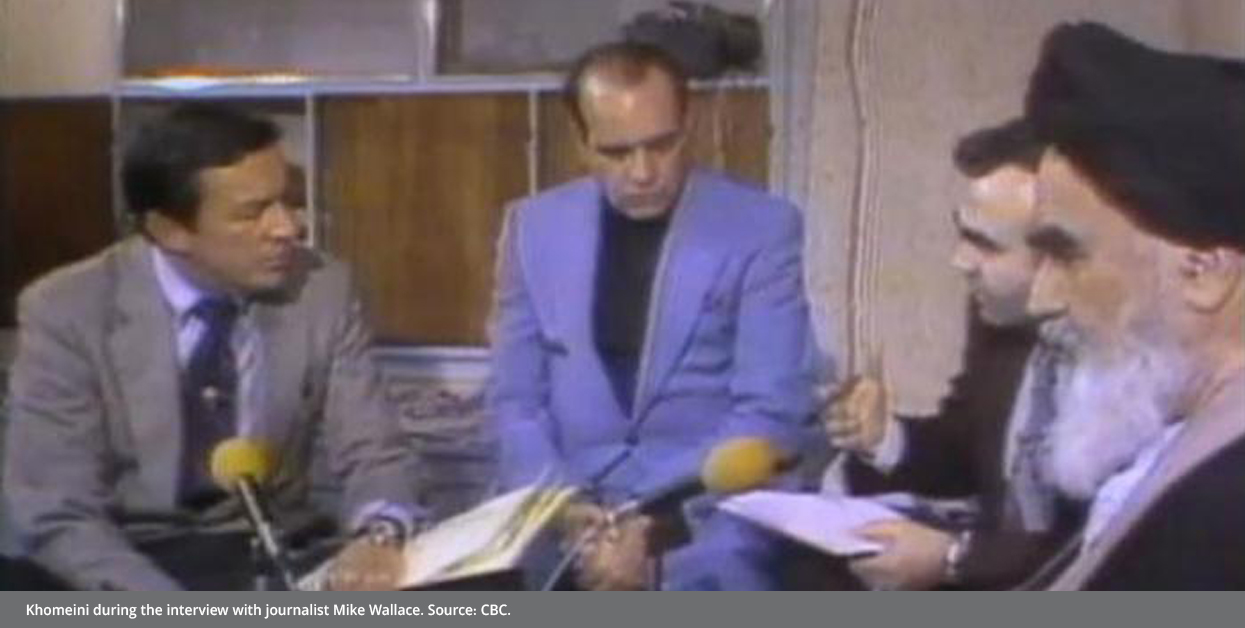
This was also clear in Khomeini's second meeting with the late Egyptian journalist; Professor Mohamed Hasanein Heikal, where Khomeini called on the Islamic peoples, especially the Egyptian people, to revolt against the rulers, replace them, and to get the inspiration from what happened in Iran, where Khomeini says "I am desperate of governments. But for the peoples, it is different, the Egyptian people have a rule, and Anwar Sadat has another rule, as well as other peoples for other governments".
This discourse has an impact on Islamic extremist groups in Egypt in particular. Ayman al-Zawahiri, the current al-Qaeda leader, and the emir of the Egyptian Jihad, says "The activity of these young people is moving, after taking control of the university, towards a mass action outside the university. One of their most important activities was the protests, and the mass conferences to protest against the reconciliation with Israel, and Sadat's reception of the Shah of Iran in Egypt"[10]. The aforesaid Fatwa (Islamic jurisprudence order) from Khomeini came before the one from Salam Faraj, the Egyptian jihad theorist, which he mentioned in his book "The Absent Duty". That fatwa was considered a document for the assassination of Sadat by the jihadists.
2. The First State with an Islamic Character after the Fall of the Ottoman Caliphate 1924
It is a state ruled by clerics, in which the mandate is administered by the Faqih, the matter which made this state be a central system that speaks on behalf of all Muslims, engaging in a "holy jihad" against whosoever it deems different therefrom. This view is the product of Khomeini's perception and that of Sayyid Qutb, which is that this religion is undertaken by the militant vanguard of the mujahideen. Khomeini emphasizes this unilateral and violent conception of Islam by saying "Islam is the religion of the mujahideen".[11]
3. The Doctrine of Exporting the Revolution to the Islamic World
Khomeini's ambition was not only national. He deems nationalism as idol and tyrant, as seen by Sayyid Qutb and other extremist theorists. Khomeini saw himself, and his revolution, as an international and global message. Khomeini confirmed this, on the first anniversary of the Islamic Revolution on February 11, 1980, by saying "We are working to export our revolution to different parts of the world, because it is an Islamic revolution".
Khomeini has always addressed the Arab and Islamic peoples, calling on them to revolt against their rulers. Shortly after the success of the Iranian revolution, Khomeini addressed the Egyptian people by saying "The Egyptian people should know that if they revolt as the Iranian people revolted, they will thwart conspiracies, and that you will win. The people of Egypt should not fear their government, and should not pay attention to their laws. Just as our people broke the barrier of fear and the curfew, the Egyptian people must crowd the streets and roads".
Supporting International and Regional contexts: the Occupation of Afghanistan and the Launch of the Peace Process
The international contexts, particularly the Soviet occupation of Afghanistan in 1979, the launch of what was later known as the Afghan jihad, as well as the launch of the Egyptian peace process with Israel in 1978, and the feelings these events aroused for the nation, were a golden opportunity for Khomeini's discourse and the slogans of the Iranian Islamic Revolution, to find its strong opportunity, and deeply influence in various countries of the Muslim world.
So, it can be said that there are many signs relating the Iranian Islamic Revolution with the radical ideas. The first of which has led to the expansion of the influence, spaces of extremism, and radicalization in various aspects of life. The greatest impact of the Islamic Revolution, was present in the behavior of extremist groups in particular. The groups of "Egyptian Jihad" rushed to unite in a single organization, led by Mohamed Abdel Salam Faraj, after the success of the Khomeini revolution, which resulted in the assassination of Egyptian President Anwar Sadat in 1981.
The waves of radical influence and radicalism broke loose throughout the Arab and Muslim world, with the momentum of the success of Khomeini's revolution and his discourse. This was attributed to the fascination of broad sectors -from different trends- with Khomeini and his populist presentation and slogans. His populist presentation and slogans monopolize Islam, and monopolize talking on behalf of the nation and all its sects, not just the Imam reference, despite Khomeini sprang out and emphasizes on such reference.
Thus, the Muslim Brotherhood and Iran have met in calls for the Islamization of laws and societies. This has an impact on many Arab countries. Such risk was, particularly, is repeating the model of the Islamic Revolution in Iran. A model that the Muslim Brotherhood seeks to apply in their areas of activity, as it was clearly demonstrated after the so-called "Arab Spring". But changes in societies between 1979 and 2011 prevented the response and momentum required for the rise and continuity of Islamist groups.
References
[1] (The Islamic unity resembles our faith and the destruction of all ideas of ignorance represent): an article for the Iranian website Al-Wefaq Online, published on October 19, 2021, available at the following link: https://al-vefagh.ir/News/341104.html
[2] Hassan al-Banna, Muslim Brotherhood and Caliphate, Wikipedia Muslim Brotherhood, available at the following link: https://www.ikhwanwiki.com/index.php?title=%D8%A7%D9%84%D8%A5%D8%AE%D9%88%D8%A7%D9%86_%D8%A7%D9%84%D9%85%D8%B3%D9%84%D9%85%D9%88%D9%86_%D9%88%D8%A7%D9%84%D8%AE%D9%84%D8%A7%D9%81%D8%A9
[3] Mohammed Al-Dabwly, Brotherhood and Iran. Single roots, interlocking branches and relationships without a future, Reference Website, Publish Date August 14, 2018, available at: https://www.almarjie-paris.com/3324
[4] Abdul Wahab Al-Effendi, Islamists and Sectarianism, Arab Website 21, Publish Date April 28, 2015, available at: https://arabi21.com/story/827317/%D8%A7%D9%84%D8%A5%D8%B3%D9%84%D8%A7%D9%85%D9%8A%D9%88%D9%86-%D9%88%D8%A7%D9%84%D8%B7%D8%A7%D8%A6%D9%81%D9%8A%D8%A9
[5] Moataz Mamdouh, Mutual Influence between the Iranian Revolution and Sunni Political Islam, Ida'at Site. Published on February 18, 2017, available on: https://www.ida2at.com/mutual-influence-between-iran-revolution-and-sunni-political-islam/
[6] Alliance of Political Islam: Iran and the Muslim Brotherhood, an article for The European Eye on Extremism, published on December 6, 2019, is available at https://eeradicalization.com/ar/%D8%AA%D8%AD%D8%A7%D9%84%D9%81-%D8%A7%D9%84%D8%A5%D8%B3%D9%84%D8%A7%D9%85-%D8%A7%D9%84%D8%B3%D9%8A%D8%A7%D8%B3%D9%8A-%D8%A5%D9%8A%D8%B1%D8%A7%D9%86-%D9%88%D8%A7%D9%84%D8%A5%D8%AE%D9%88%D8%A7%D9%86/
[7] Hammad al-Salami, Iran and the Brotherhood. The Devil's Quran. Al Arabiya website, published date: March 28, 2021, https://www.alarabiya.net/saudi-today/views/2021/03/28/-%D8%A7%D9%8A%D8%B1%D8%A7%D9%86-%D9%88%D8%A7%D9%84%D8%A7%D8%AE%D9%88%D8%A7%D9%86-%D9%82%D9%90%D8%B1%D8%A7%D9%86-%D8%A7%D9%84%D8%B4%D9%8A%D8%B7%D8%A7%D9%86-%D8%9F-
[8] The mutual influence between the Iranian revolution and Sunni political Islam, a former source.
[9] Tamer Badawi and Osama al-Sayyed, Mismatched Expectations: Iran and the Muslim Brotherhood in the wake of the Arab uprisings, Malcolm Kerr Carnegie Center for Middle East Studies, Published March 28, 2019, available at: https://carnegie-mec.org/2019/03/28/ar-pub-78702
[10] Ayman al-Zawahiri, knights under the banner of the Prophet, the Platform for Tawhid and Jihad, without history, electronic i1, p. 16.
[11] Ruhollah Khomeini, Islamic Government, dateless, Shiite Online Library, 3rd Edition, p. 8.
Keep in touch
In-depth analyses delivered weekly.
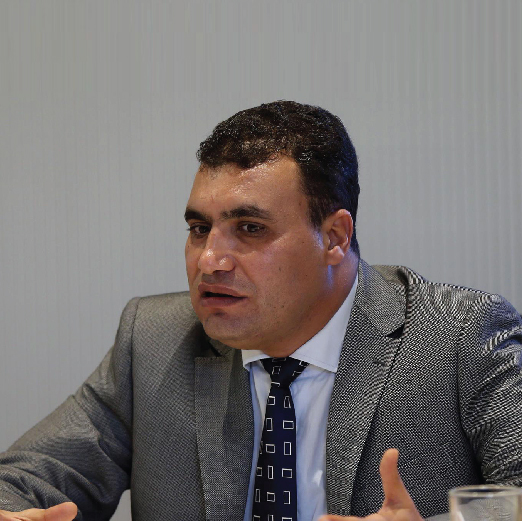
Related Analyses:







